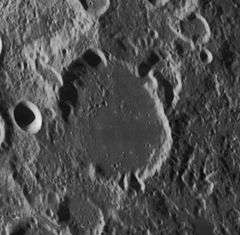Cannon (crater)
|
Oblique Lunar Orbiter 4 image | |
| Coordinates | 19°54′N 81°24′E / 19.9°N 81.4°ECoordinates: 19°54′N 81°24′E / 19.9°N 81.4°E |
|---|---|
| Diameter | 56 km |
| Depth | Unknown |
| Colongitude | 280° at sunrise |
| Eponym | Annie J. Cannon |

Cannon is a lunar crater that is located near the east-northeastern limb of the Moon's near side. It lies just to the northwest of the Mare Marginis, and south-southeast of the crater Plutarch. Farther to the east-northeast is Hubble.
This is a worn and eroded formation with an interior floor that has been resurfaced by lava. A small crater overlies the north rim, which forms a notch in the side. Tiny craters also lie across the rim northeast and at the southern edge. The interior is level and nearly featureless, with only a few tiny scattered craterlets to mark the surface. This floor has the same albedo as the surrounding terrain.
The crater is named after Annie Jump Cannon, an astronomer who classified 300,000 stellar bodies.
Satellite craters
By convention these features are identified on lunar maps by placing the letter on the side of the crater midpoint that is closest to Cannon.
| Cannon | Latitude | Longitude | Diameter |
|---|---|---|---|
| B | 17.5° N | 80.0° E | 31 km |
| E | 19.2° N | 79.1° E | 22 km |
References
- Andersson, L. E.; Whitaker, E. A. (1982). NASA Catalogue of Lunar Nomenclature. NASA RP-1097.
- Blue, Jennifer (July 25, 2007). "Gazetteer of Planetary Nomenclature". USGS. Retrieved 2007-08-05.
- Bussey, B.; Spudis, P. (2004). The Clementine Atlas of the Moon. New York: Cambridge University Press. ISBN 978-0-521-81528-4.
- Cocks, Elijah E.; Cocks, Josiah C. (1995). Who's Who on the Moon: A Biographical Dictionary of Lunar Nomenclature. Tudor Publishers. ISBN 978-0-936389-27-1.
- McDowell, Jonathan (July 15, 2007). "Lunar Nomenclature". Jonathan's Space Report. Retrieved 2007-10-24.
- Menzel, D. H.; Minnaert, M.; Levin, B.; Dollfus, A.; Bell, B. (1971). "Report on Lunar Nomenclature by the Working Group of Commission 17 of the IAU". Space Science Reviews. 12 (2): 136–186. Bibcode:1971SSRv...12..136M. doi:10.1007/BF00171763.
- Moore, Patrick (2001). On the Moon. Sterling Publishing Co. ISBN 978-0-304-35469-6.
- Price, Fred W. (1988). The Moon Observer's Handbook. Cambridge University Press. ISBN 978-0-521-33500-3.
- Rükl, Antonín (1990). Atlas of the Moon. Kalmbach Books. ISBN 978-0-913135-17-4.
- Webb, Rev. T. W. (1962). Celestial Objects for Common Telescopes (6th revised ed.). Dover. ISBN 978-0-486-20917-3.
- Whitaker, Ewen A. (1999). Mapping and Naming the Moon. Cambridge University Press. ISBN 978-0-521-62248-6.
- Wlasuk, Peter T. (2000). Observing the Moon. Springer. ISBN 978-1-85233-193-1.
